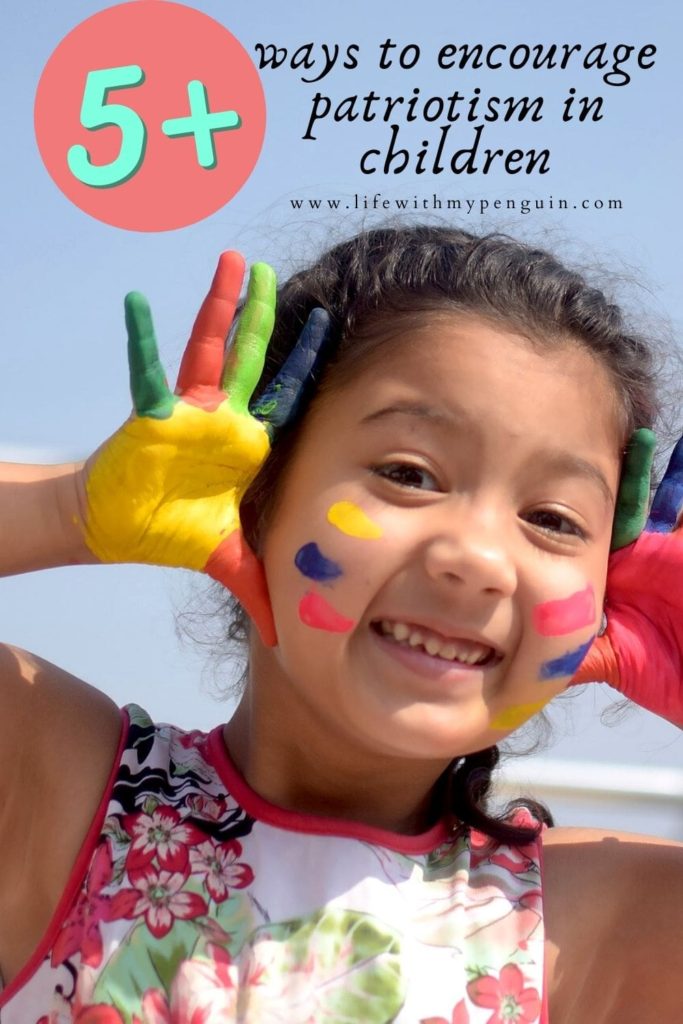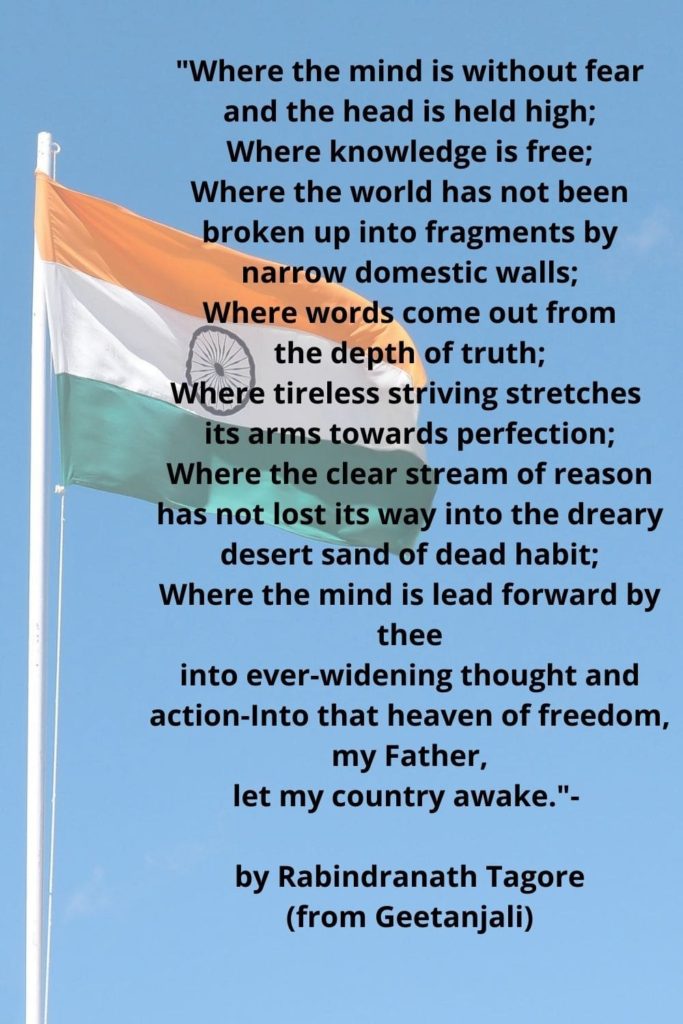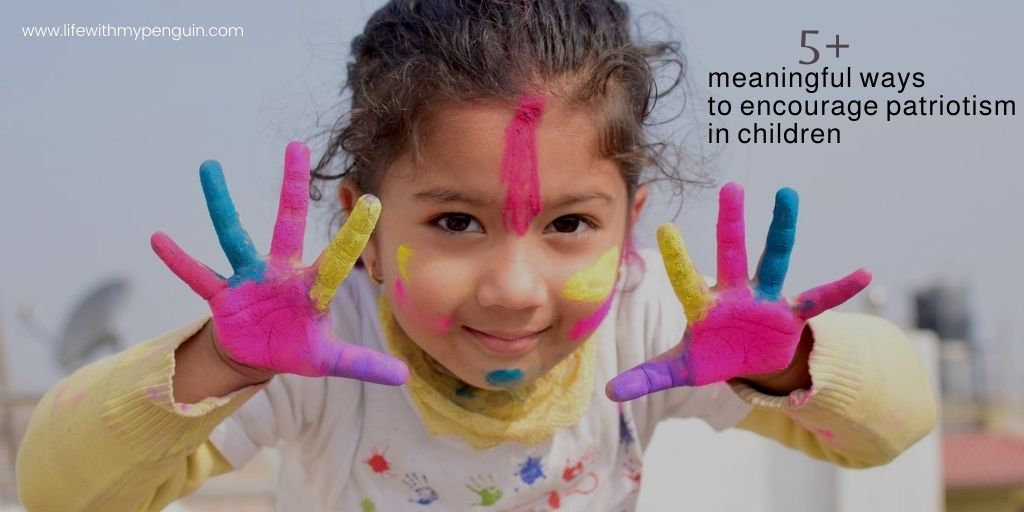On 15th August 2020, India celebrated its 74th Independence Day. With the outbreak of pandemic this year people maintained social distancing and stayed indoors. Well mostly. My Instagram feed is full of lovely children exhibiting their art and craft, which is wonderful. Meanwhile, let’s understand that patriotism should never stick with dates. Instilling ideas and values of patriotism in children shall help them to become responsible citizens of the country.
Being a proud responsible Indian never used to be controversial. Well, until recent years. We used to assume each of us is patriotic. No one needed to justify this humble thought. Then time changed, patriotism emotion got tangled with belief and faith. Words like patriotism, nationalism, and religious believes got were arm twisted. People are divided time and again as they are manipulated as the vote banks, not citizens. Notwithstanding, we are proud of being citizens of the nation with its strengths and flaws. Proud of its contribution to the world and humanity.
Patriotic. What does it mean?
15th August and 26th January are much more than public holidays.
Patriotism is the emotion of love, respect, and belongingness towards one’s nation. There is no structured definition of the feeling as it varies with people. For some it is the means respecting the flag, abiding the rules of law; for others, it may be supporting the leader, President or Prime Minister. The idea of patriotism is open for interpretation.
Patriotism is not just the pride we take; it also includes the actions we take for the country and countrymen.
Meaningful ways to encourage patriotism in children
With the spread of news media, the time of national unrest (that we face often) is known to kids. They are age-appropriately aware of events of attacks, loss of brave hearts, and boiling political tension. So, children need clarity in understanding about patriots, patriotism, and ways of practice in daily life.
Means to display patriotism are widespread. One might demonstrate it by flying the Tricolor flag. The flag is a symbol of the nation’s pride, values, and freedom. It represents the country in the world. The flag of the country is a portrait of its history. It unifies the country. Citizens can take a step further and salute the flag.
However, there are more ways to show patriotism that stands out and leaves an impact. A major one being voting. A minor national can’t vote until they turn 18, but they can share their thoughts in the community.

1 – Lead by example
Parents are the first teachers. Children choose parent’s actions over words to act upon. Encouraging kids to eat right, exercise, maintaining hygiene, and limiting screen time may not be enough to instill healthy habits. Parents need to lead by example. Similarly, parents need to ingrain patriotism with actions.
In our family, we have the habit of carrying brown paper bags while traveling. We collect all litter, be it toffee wrappers, fruit peels, used napkins, etc in the paper bag until we reach the destination or locate a dustbin midway. A simple yet impactful way to keep streets clean and step to conscious travel. For example, help children to understand the need for ‘Swacch Bharat Abhiyan’.
Paying taxes is another crucial thing. The government uses funds that we pay in form of taxes to the salary of government officials, make and/or maintain roads, parks, public places, and government programs (education, health, and hygiene, etc). A good citizen needs to comprehend, learn, and pay taxes. Better education for children starts with skills that will provide long term benefits. Parents can discuss the financial understand even at a grocery store, compare the price of items, talk about the tax paid, and reasons.
India is a unique country. We have many languages, religious beliefs, food, culture, and climate. We desire to raise broad-minded children, who are open to new experiences. One who does not discriminate or impose their opinions on others, who listen, help, and care. We want them to develop into responsible adults. Teaching children to be tolerant and accepting diversity starts at home. Expose children to differences among people early in life. Let them embrace diversity.
2- Discuss the flag and national anthem.
While we hoist the tricolor flag, parents, caregivers, or teachers can discuss the flag with children. Start with basics, like the color, size, meaning of the colors. Gradually move to the importance of chakra, designer of the flag, and more.
Demonstrate the right way to display flag and fold it.
Facts about the Tricolor national flag –
- Tiranga, our Indian national flag is a horizontal tricolor of Indian saffron at the top, white in the middle and dark green at the bottom in equal proportion. The middle white panel bears the design of Ashoka Chakra in navy blue color with 24 equally spaces spokes at the center. In 2002 the Flag code of India was implemented.
- Indian saffron signifies sacrifice and patriotism. The white color stands for truth in words, actions, and purity in thoughts. Green at the bottom signifies life and prosperity.
- The Ashoka Chakra stands for progress and symbolizes the Power of the State governed by Dharma. The Chakra intends to show that this is life in movement and death in stagnation.
- The flag was designed by Pingali Venkayya.
- In 1921 Gandhi ji spoke about the flag (Swaraj Flag). There were two colors, red for the Hindus, and green for Muslims.
- The design was then modified to replace red with saffron and to include a white stripe in the center for other religious communities, and provide a background for the spinning wheel.
- Days before independence, the Swaraj flag was modified replacing charkha (spinning wheel) with Ashoka Chakra.
- Karnataka Khadi Gramodyoga Samyukta Sangha based in Hubli is the only licensed flag production and supply unit in India.
Arts and crafts are wonderful way to reinforce the learning about the national flag.
Jana Gana Mana is the national anthem of India. Right from kindergarten children are encouraged to stand for 52 seconds and recite it. However, standing for the national anthem became a topic of the debate a few years ago. Making the need to educate children about it more crucial.
Quoting words of Sadguru, “A nation is instilled in the form of its constitution, and the symbolism of the nation comes to us in the form of a flag and of an anthem. So, the question is, if we want to operate, live, prosper and excel as a nation, is it important to have pride and allegiance to the nation?”
We need to build a strong sense of nationhood in the minds and soul of every citizen in this country. We need to be patriots and encourage patriotism in children.
Facts about the national anthem –
- “Jana Gana Mana Adhinayaka” was composed by Rabindranath Tagore on 11 December 1911. Later it was first sung later in the month on 28th December at the Calcutta session of Congress.
- In 1942, ‘Jana Gana Mana’ was performed (not sung) for the first time in Hamburg.
- The Jana Gana Mana was declared as India’s National Anthem on 24th January 1950.
- Subhas Chandra Bose had authorized a free translation of the National Anthem of India from Sanskritized Bengali to a well-known form in Hindustani. Captain Abid Ali of the Indian National Army (INA) had shaped the version called ‘Subh Sukh chain’.
- The official version of the National Anthem of India should take 52 seconds.
3 – Talk about freedom fighters
Talk to children about the freedom fighters, their ideologies and their role in the freedom struggle. Learning about the heroes would leave a deep impact on children. Stories of freedom fighters encourage children to dare, a voice against unfairness, and find courage in real-life situations.
Books and bedtime stories are great ways to know about the freedom fighters. Add children’s books that talk about the life of heroes who laid down their lives for freedom. Also, if one accepts screen time, movies also another medium to expand patriotism in children.
Some of the books talking about Indian freedom fighters are –



4 – Discuss the constitution of India, read the Preamble
The Indian constitution is the world’s longest for a sovereign nation. Don’t wait for civic classes to talk with children about the rights of citizens, power of government, and more. Let their intrusive mind ask questions and parents reply to the complete answers heartily. If the query remains unexplained let the parent-child explore the key together.
The simplify about the Indian Constitution for children is that it’s the supreme law or set of rules in India that govern us all. It was adopted by the Constituent Assembly on the 26th of November, 1949. However, it only came into effect on the 26th of January, 1950, Republic day.
Few children books that revolve around B.R. Ambedkar and Constitution of India are –



5 – Meet the soldiers or retired personnel
As children, we often used to wait for our neighbor chacha who was an Army Major. He used to share his stories of days maintaining peace at borders or internal civil unrest. Those memories are still livid. We used to post thank you letters to the Indian Armed Forces.
Parents can help children to meet soldiers or retired personnel and get candid about their experiences. Celebrate Army Day on 15th January, Navy day on 4th December, Air Force Day on 8th October every year. The Armed Force Flag Day is celebrated on 7th December. Further, the Armed Forces Veteran’s Day is celebrated on 14th January.



Encourage children to volunteer along with family that help soldiers and veterans. The act helps children to develop empathy about the real life heroes while building patriotism in them.
6 – Visit museums and historic places
Travelling teaches a lot to children. They get a chance to visit the places where history was created. While visiting museums and historic places keep talking about the stories of people involved in the place, the importance of place, identify pictures and items displaced, so on. Children also tend to form a comparison of past and current scenario. This will inculcate reasoning in them.
Related – Teaching history to children | Travel with kids

We wish to get dialogue exchange on this topic. If you have more ideas about instilling patriotism in children do share with us.
Disclaimer: This post might contain affiliate links. These links provide me with a small percentage commission at no extra cost to you. For more information read the disclosure.
Picture credit – Image by Prashant Sharma from Pixabay
This blog post is written for SpeakEasy Blogging Challenge 2.0 hosted by Ruchi and Dipika“


I enjoyed in this post! Great for kids to learn Really Pretty colors! Good work
बहुत अच्छी बातें लिखी है.. आज बच्चों को इसकी सिख देनी जरुरी है..
Thank you so much, Pooja ji!
Nice post… appreciate your post
Thank you, Ramya. Keep visiting us.
Leading by example is my motto too! My little one is aware of the national flag and understands that we respect it. I liked your thoughts of teaching smaller things like carrying paper bag or paying taxes diligently. Each lesson counts will making citizens of tomorrow.
Little steps for a better nation, a better future. Thanks for reading, Disha.
We are on same page for this prompt Pragnya. Teaching kids values and importance of nation by leading example is surely the best way.
Just came across your post, we are truly on the same page 🙂
We love to discuss all about India, great leaders and few interesting facts while having dinner together or when we all sit together for tea.
The best way is need to discuss.
Mealtimes are great for conversations like this.
Very useful post Pragnya. Thanks for the book recommendations! Can’t wait to read them to my little one.
I am so glad you found this post useful. Keep visiting us.
I agree we as parents can bring these emotions for our country in our kids!! I am glad that you are part of this blogging challenge!!
Happy to be a part of this blog challenge, Ruchi 🙂
Interesting ideas for inculcating patriotism and a sense of national pride and identifying with being indian from a very young age.
Thanks for sharing your thoughts, Ishieta
Great and fantastic post, loved all your pointers that can certainly help kids to feel great for our India. The ways you had discussed are worth practicing by all parents to help their kids learn more with these activities. Your book recommendations are as always great reads for kids. Where the mind is without fear is a very inspiring poem and guess what I recited it on 15th too.
https://anchor.fm/petalsbypragun/episodes/Poetry-platter—Where-the-mind-is-without-fear-eiburc
I have heard your podcast Pragun. This poem is an absolute fab. Thanks for stopping by 🙂
very good pointers to help our kids develop the love and respect towards our country. You’ve done a Great job writing the post, I loved it totally.
Thank you for your kind words.
Amazing detailed post pragnya.. talking about those things to the kids and also doing Activities related to it help them understand better.. thanks for the book recommendations.
Thanks for stopping by, Vandana.
Good ideas to talk to kids. I have a 5year old and she was asking me.few questions about the same. I could answer her a few. This post is so helpful. 🙌🏼👍🏼
Glad to hear this.
This is a FANTASTIC post! I run a parenting group called Happy Parenting India – consider this as a personal invitation to post in that group. Keep writing such informative posts! Kudos!
https://www.facebook.com/groups/HappyParentingIndia/
Haha. Thanks for your encouragement Mayura.
You have made good points, we must lead by example. as kids do what they see rather than what we ask them to do.
Glad our thoughts match. 🙂
yes, I try to answer my kids and want them to understand what India means to us and how we get freedom. Great POST, YOU HAVE MADE MORE EASY TO SHARE MORE DETAILS WITH MY KIDS
You are doing fantastic, Gurjeet. Thanks for reading.
I have bookmarked this detailed post for the next national festival. Very informative
Music to my ears. Thanks for reading, Mandavi.
Great post dear and you had suggested some great ways to teach our kids patroitism. specially I liked the idea of visiting historic places and museum. kids learn very fast with practical experience. planning such trip would be a great experience for kids to learn more about the importance and history of that place and related event. this kind of trips raise a natural curiosity in kids and they learn all important facts naturally.
That’s something we live by. Aga Khan palace was our frequent destination once, my child do know titbits about Gandhi ji. That’s enough, right? Thanks for sharing your thoughts, Surbhi.
What a well researched post it is! First of all, I liked the topic you have chosen to discuss here. It’s said, morning shows the day. The seed of patriotism should be planted inside the heart of children as early as possible so that they become aware of their country, their pride, their motherland. I liked this idea. And, the points you have quoted and explained here, all of them are very relevent. I liked the last two points most as they are something very unique in their own ways. Children could learn to respect their country this way. Loved the post and the take aways. Also, it’s engraved in my heart that we should be responsible towards our country too. Beautiful write up Pragnya.
Humbled Swarnali, Your words make my day. Thank you.
Such a lovely post Pragnya. Very well written. Loved the books that you have mentioned.
Thank you, Debi!
A very well written article. Loved all the points so apt. The pictures you’ve added of books is amazing. Loved the post.
Deepika
Glad you liked it, Deepika.
Wonderful with practical tips to instill patriotism in children 😊🙏
Thanks for visiting, Ranjini.
Kids learn from example and setting a a good example is the responsibility of parents. The ways you have suggested can be very helpful for instilling the values and more than that making them understand the meaning of the terms, it’s significance.
Our thoughts do echo then 🙂
Really helpful ways to educate today’s generation about our country.
Thanks for sharing your thoughts Nitisha. 🙂
Excellent presentation…worth reading
Thank you! Glad you liked it.
Very nice post Pragnya, liked the book recommendations as well. Very useful post.
Thank you for your kind words Priyanka!
Children learn what they see.. So definitely we should set right example in front of them. Art and craft and any creative activities makes them learn much better.
Ways of learning depend on a child, whatever works and brings joy. Thanks for visiting, Swati
I don’t think we give so much thought to this aspect. So glad you decided to talk about this.
My heart is full of gratitude for your kind words, Sonia.